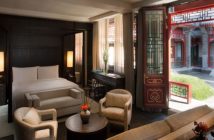
Just returned from a six-day tour of Shanxi with our 20-month-old, wife and in-laws in tow. I’ve been to Shanxi on two previous occasions, to Taiyuan/Pingyao and a few of the surronding villas (i.e. Qiao Jia Dayuan), but this time our journey took us to spots up north, near Datong, then down to Wutai Shan and then to Taiyuan/Pingyao for the last stretch.
It’s always hectic traveling with a toddler (not to mention doting grandparents), but our trip was facilitated by the PLA, for whom my father-in-law served as a general before retiring two years ago. Our transport and accommodations were all provided for and I had the unique opportunity to stay in guesthouses on the campuses of PLA barracks in Datong and Shanxi.
Aside from the sites themselves, what was most memorable about this trip were the meals, every single one of which we were treated to by my father-in-laws former colleagues and associates in the ornate private dining rooms of the guesthouses. For five straight days we were treated to lavish 30-course lunches and dinners (I kid you not) consisting of the finest selection of appetizers, entrees and noodle dishes (including wo wo mian, pictured below) indigenous to the region.

Even breakfasts were 20-dish affairs — everything down to the fried dough sticks (you tiao) were specially prepared by the most experienced chefs in the region (said dough sticks had their own dedicated chef whose sole job it was to hand-make them piping hot each morning).
I could go on and on about the food, but I was too busy stuffing my face and being goaded into shots of bai jiu by my curious hosts (who kept referring me as "our international friend" – guo ji you ren – 国际友人) as we pounded shot after shot of Wuliangye and a special medicinal kind of bai jiu native to Shanxi. I managed to hold my drink, but the distinct taste and smell of bai jiu fumes are still lingering in my memory.


Despite the 10/1 crowds, the sites themselves were for the most part impressive – particularly Xuankong Si (the Hanging Monastery) outside of Datong and Yungang Grottoes (Yungang Shiku), site of an amazing collection of 1,500-year-old Buddhist rock carvings.


The latter in particular is still a work in progress as the regional government is in the process of turning the surrounding area into a large park/parking lot (the grottoes used to sit right beside the highway), so it was incredibly dusty, but well worth the grime and grit.


The walled-city (and Unesco World Heritage Site) of Pingyao was as crowded as ever and has basically morphed into a Yandai Xiejie/Nanluoguxiang on steroids (I was last there in 2003, when it was still emerging as a tourist hotspot) – complete with Western breakfast cafe-cum-bars, a four-star mega hotel, English menus everywhere and jostling people in all directions. The place still is a great destination for a short family trip from Beijing, but definitely save it for off peak seasons.

Most disappointing was Wutai Shan, which seems to be basically a Buddhist theme park – the pristine natural scenery was blighted by way too many hotels and even banks. But culturally speaking, it’s significance to Chinese pilgrims and regular folks cannot be understated.

Also skippable is Qiao Jia Da Yuan (the Qiao Family Compound) – this was the mansion of a rich Qing dynasty merchant family (one of many in the region) as well as the location of Zhang Yimou’s Raise the Red Lantern, but it’s claustrophobic walls, aggressive hawkers and chaotic crowds make it much less impressive. There are other villa complexes, including Wang Jia Da Yuan and Chang Jia Da Yuan that are perhaps worth seeing, but we didn’t make it to them this time around.

On our last day we visited Jinci – a distinct Song dynasty temple with a pleasant garden, natural spring and structures bearing statues of various deities and a shrine dedicated to the ancestor of the Wang clan, the largest in the country (of which my in-laws are members). What I found most striking was this collection of elegant Yuan dynasty figures playing instruments that were in the process of being renovated during our visit, as well as the impressively large guardian deity statue pictured below.

Shanxi is of course also known for its coal mines, and with it, some of the most polluted air in China. We found the air quality in Datong during the first few days to be much nicer than the latter half in Taiyuan – presumably because of the holiday measures to keep the air clean – but our sinuses suffered all the same. Dryness and coal dust are not pleasant things when it comes to your nostrils.

Like all trips, this one had it’s ups and downs, but it was well worth it – especially when we whisked back in town to the Beijing West Railway station on the 3-hour high-speed maglev from Taiyuan. As we saw the heaving, ant-like crowds crossing Tiananmen Square in the car that evening after we arrived, we realized that getting away to relatively peaceful Shanxi was probably the best way we could have spent our holiday (text and photos by Jerry Chan).



